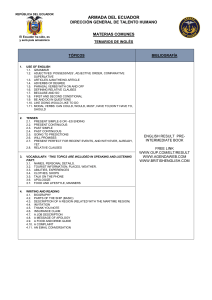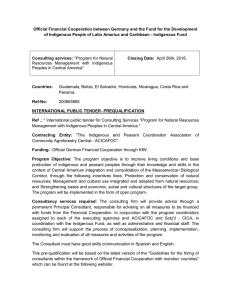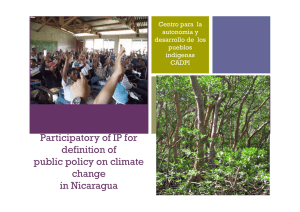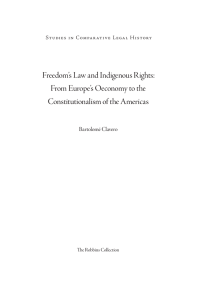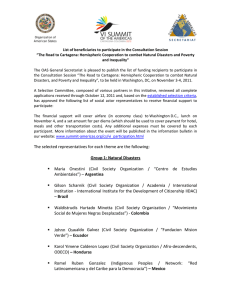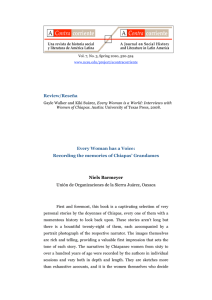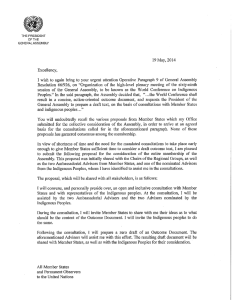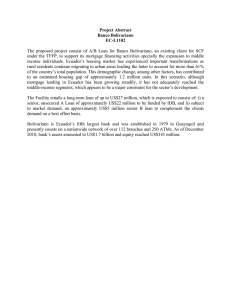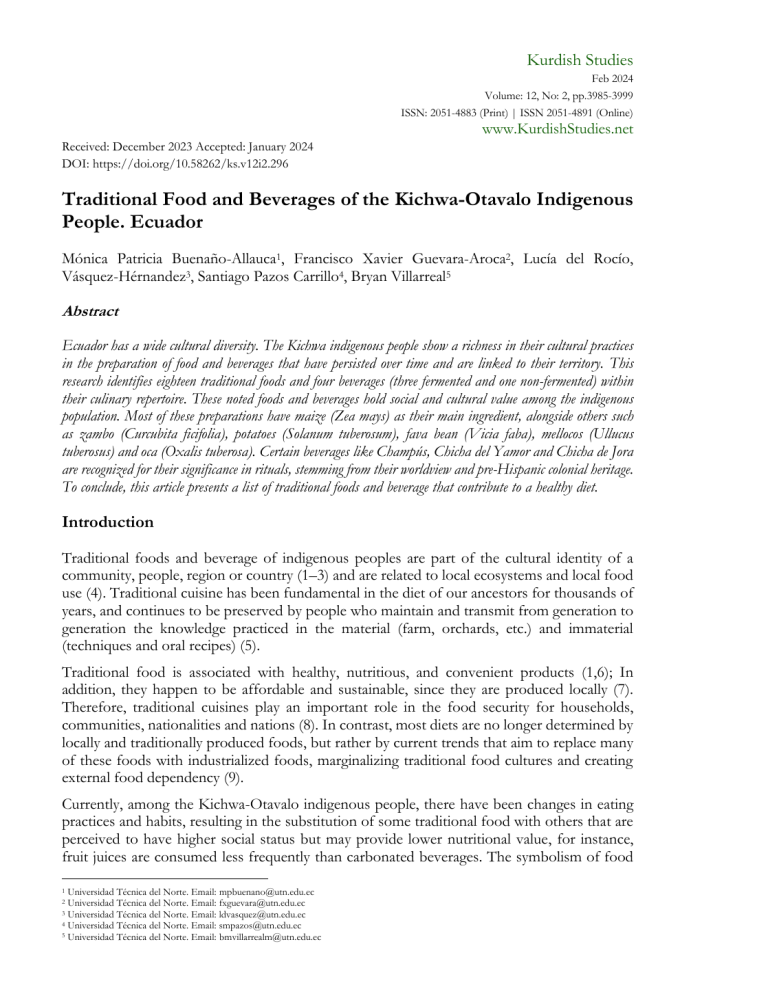
Kurdish Studies Feb 2024 Volume: 12, No: 2, pp.3985-3999 ISSN: 2051-4883 (Print) | ISSN 2051-4891 (Online) www.KurdishStudies.net Received: December 2023 Accepted: January 2024 DOI: https://doi.org/10.58262/ks.v12i2.296 Traditional Food and Beverages of the Kichwa-Otavalo Indigenous People. Ecuador Mónica Patricia Buenaño-Allauca1, Francisco Xavier Guevara-Aroca2, Lucía del Rocío, Vásquez-Hérnandez3, Santiago Pazos Carrillo4, Bryan Villarreal5 Abstract Ecuador has a wide cultural diversity. The Kichwa indigenous people show a richness in their cultural practices in the preparation of food and beverages that have persisted over time and are linked to their territory. This research identifies eighteen traditional foods and four beverages (three fermented and one non-fermented) within their culinary repertoire. These noted foods and beverages hold social and cultural value among the indigenous population. Most of these preparations have maize (Zea mays) as their main ingredient, alongside others such as zambo (Curcubita ficifolia), potatoes (Solanum tuberosum), fava bean (Vicia faba), mellocos (Ullucus tuberosus) and oca (Oxalis tuberosa). Certain beverages like Champús, Chicha del Yamor and Chicha de Jora are recognized for their significance in rituals, stemming from their worldview and pre-Hispanic colonial heritage. To conclude, this article presents a list of traditional foods and beverage that contribute to a healthy diet. Introduction Traditional foods and beverage of indigenous peoples are part of the cultural identity of a community, people, region or country (1–3) and are related to local ecosystems and local food use (4). Traditional cuisine has been fundamental in the diet of our ancestors for thousands of years, and continues to be preserved by people who maintain and transmit from generation to generation the knowledge practiced in the material (farm, orchards, etc.) and immaterial (techniques and oral recipes) (5). Traditional food is associated with healthy, nutritious, and convenient products (1,6); In addition, they happen to be affordable and sustainable, since they are produced locally (7). Therefore, traditional cuisines play an important role in the food security for households, communities, nationalities and nations (8). In contrast, most diets are no longer determined by locally and traditionally produced foods, but rather by current trends that aim to replace many of these foods with industrialized foods, marginalizing traditional food cultures and creating external food dependency (9). Currently, among the Kichwa-Otavalo indigenous people, there have been changes in eating practices and habits, resulting in the substitution of some traditional food with others that are perceived to have higher social status but may provide lower nutritional value, for instance, fruit juices are consumed less frequently than carbonated beverages. The symbolism of food 1 Universidad Técnica del Norte. Email: [email protected] 2 Universidad Técnica del Norte. Email: [email protected] 3 Universidad Técnica del Norte. Email: [email protected] 4 Universidad Técnica del Norte. Email: [email protected] 5 Universidad Técnica del Norte. Email: [email protected] 3986 Traditional Food and Beverages of the Kichwa-Otavalo Indigenous People. Ecuador as a marker of social status is evident even during the Colonial and Republican eras of Ecuador, where foods such as potatoes and guinea pigs, closely related to indigenous cuisine, were relegated from the banquet menus served to the Liberator Simón Bolívar in 1822 (10). On the other hand, the rise of a class of textile merchants6 indigenous transnationals throughout the last decades (11), the remarkable social and commercial success that the merchant indigenous people has acquired has created an attitude of superiority towards other rural indigenous communities. However, the indigenous people of the rural sector are considered “original peoples” due to the fact that they live in the communities and are more closely related to nature, customs and traditions. On the other side, the urban indigenous, due to the fact of traveling and interacting with a global world, adopt different customs (12) including the selection of foods and culinary preparations. Therefore, it is important and relevant to identify and document the traditional foods consumed by the Otavalo indigenous population. In the culture of the Otavalo indigenous people, the food on the table is the result of harmonious relationships with Pachamama7. These relationships integrate knowledge, wisdom, sensitivity and values, based on community norms and reciprocity between the subjects (indigenous/deities); where Otavalo farmers show respect for Pachamama. They are not only aware of the lunar cycles8, seasonal changes, and other natural forces but also conceive themselves as integral agents within this complex system. This kind of agroecological and culinary knowledge connects them to nature and vice versa, particularly through sacred rituals and celebrations (13); Thus, for example, the consumption of Chicha9, it could be considered one of the oldest beverages in Latin America, in the current Ecuador, the first reports of Chicha production date back to 200 BC, before the establishment of the Incas in the region (14). In the Inca period, during the Coya Raymi festival, also written Killa Raymi or Kuya Raymi (in Kichwa "The Festival of the Moon", a symbol of femininity in the Andean worldview) it was a special beverage prepared for the acllaconas (virgins of the sun) (15). Celebrations are the main setting for sharing food with family, neighbors, and friends; in the preparation of foods they are helped by the mingas10. Certain foods and the knowledge of specific culinary techniques become specialties of the locality. The transmission of transgenerational knowledge has been key to maintaining an ancestral food culture in Otavalo. Traditionally, elderly women within the indigenous community have been the primary bearers of knowledge regarding ingredients and culinary practices. Therefore, documenting this knowledge is vital to conserving, protecting and promoting the use of traditional foods. This study aimed to document traditional foods and beverages, culinary preparation practices, and their sociocultural roles in the Kichwa-Otavalo indigenous people. 6The Kichwas-Otavalo indigenous people belonged to the lowest scale of social hierarchies until the late 1940s. The “textile” fabric boom coincided with the increase in tourism at the end of the 1960s and at the beginning of the 1970s they were in great demand by tourists. By the 1980s, the Otavalo sought markets in Europe and the United States (30). In addition, achieving cultural recognition, currently the "Plaza de Poncho" is an artisan market in Otavalo and an important tourist destination nationally and internationally (31). 7Pachamama, Quechua word that translates as "Mother Earth", a deity in Quechua culture. 8The Inca Empire reached a knowledge and understanding of natural phenomena (the periodic movement of the sun and the moon), this knowledge was useful for the social (solar calendar) and agricultural (lunar calendar) organization, establishing appropriate dates for the agricultural tasks of planting, watering, pruning and harvesting, and the celebrations that accompanied them (32). After the Spanish conquest, the lunar calendar is still used in the Andean worldview. 9Chicha or low-alcohol beer. Beverage traditionally prepared, derived from the spontaneous fermentation of cereal (mainly maize). They are associated with aboriginal communities of the Andes (33). 10For Luis Cordero, the term minga means "Invitation or treat for some job. (...) Meeting of people who work, eat and drink (...) [from] Mingana. Invite for some free work, in which the guests have to eat and drink "(34). This is the central organizing principle of the traditional social structure of the Andes. www.KurdishStudies.net Allauca et al. 3987 Traditional Foods: Approaches and Concepts Based on culinary and gastronomic studies, the definition of the category "traditional cuisine" is of polysemic significance; In other words, it is loaded with various meanings and is also interrelated with various fields, such as: economics, sociology, anthropology, archaeology, etc.,(16). Food constitutes a fundamental component of the social and ecological traditional knowledge of indigenous peoples, transmitted over the years. In this context, Nor et al. (17) stated that the transmitted attributes or knowledge include the use of ingredients, preparation techniques, cooking methods, utensils, and culinary skills. The Dictionary of the Spanish Language (DLE) (18) defines “tradition”, in its third meaning, as "doctrine, custom, etc., preserved in a people through the transmission from parents to children". In other words, it suggests the transmission of cultural elements, such as knowledge, techniques, know-how, representations, memory, and heritage, among others. Therefore, tradition means generational transmission (19). In this process of generational transmission, knowledge is the element to be transferred. The definition of traditional foods has been the subject of several studies, and conceptualizing it has been complex and, at times, controversial. Nevertheless, there are several characteristics repeatedly mentioned or with similar meanings that define what constitutes a traditional food. For example, Gellynck and Kühne (20)defined traditional food products according to four criteria: (1) the production steps must be carried out in a specific area, which can be national, regional or local, (2) a local recipe (ingredient mix), origin of the material raw and/or production process, (3) having been on the market for 50 years and (4) being part of the gastronomic heritage. Guerrero et al. (21) from the perspective of traditional food consumers in six European countries, indicate that a traditional food product is a product prepared and consumed on specific celebrations and/or seasons, which is passed down from generation to generation, distinguished by its sensory properties and which are exclusive to a certain area, region or country. Also, the popularity within a specific region, an authentic way of cooking a relatively long history of consumption and production (22). Hsu et al., (23) suggest that traditional foods are related to specific cultural groups, a specific territory, local ingredients and recipes, and have been in use for over 25 years. Another author affirms that traditional cuisine comes from a popular root that is reproduced in 3 and 5 generations (24). The most frequently reported characteristics to define traditional food are associated with place, people, time, and transgenerational transmission. Table 1 presents the different characteristics that various authors use to define traditional foods. Therefore, the conceptualization of traditional food may generate different conceptual positions, which in turn converge in certain commonalities, such as the necessary resource for the transmission of culinary technical knowledge for the permanence of a preparation in current times, which in turn must be loaded with significance generates a sense of identity in a determined population, as long as traditional elements are maintained in the codification of the preparations considered traditional. Kurdish Studies 3988 Traditional Food and Beverages of the Kichwa-Otavalo Indigenous People. Ecuador Table 1: Related Characteristics to Define Traditional Foods. AuthorLink/relationshipTemporality (20) _ 50 years (21) Celebrations, specific seasons _ (22) _ Long history (23) (24) Cultural Used more group/ethnicity than 25 years 3 to 5 generations _ (45 to 75 years) Origin of the recipe Other aspects _ Authentic It is part of the gastronomic heritage _ _ Distinguished for its sensory properties Popular in area or region _ Authentic way of cooking _ Specific territory Local Local _ Popular _ _ _ _ Know-how. What? (raw material to use), How? (techniques and production processes), and Who? (person in charge of preparation) Geographical Origin of space ingredients Determined area (national, regional or local) Exclusive to a zone, region or country Cultural Defined place, significance (ritual 25 years or a (19) local, regional and symbolic generation or national character) _ Recognizing the importance of traditional foods in culture, heritage, health, and agroecology, the European Union has developed mechanisms that have been significant milestones in the European Quality Policy. Thus, in the European region a traditional food must keep three quality seals linked to the origin: Protected Designation of Origin (PDO) refers to an agricultural or food product that is produced, processed, and prepared in a defined geographical area; Protected Geographical Indication (PGI) describes a product that is produced and/or processed and/or prepared in a defined geographical area, and Traditional Specialty Guaranteed (TSG) refers to food products made with traditional or distinctive ingredients due to their traditional composition or process of production (19). In Ecuador, there is a legal figure called “Especialidad Tradicional Garantizada” (ETG) registered in the Organic Code of the Social Economy of Knowledge, Creativity and Innovation (25), legal protection is granted to a type of agricultural or food product that has specific characteristics that distinguish it from others. These characteristics may include the use of traditional ingredients, a specific composition, or traditional methods of preparation or production. However, it is important to note that this protection is not linked to a defined geographical area, otherwise, the food will not be registered as ETG. Methodology Study Area The study area is the Otavalo canton, located in the northwestern province of Imbabura in Ecuador, at an altitude ranging from 2,460 masl in the cantonal capital to the top of the www.KurdishStudies.net Allauca et al. 3989 Imbabura volcanoes at 4,609 masl and Cotacachi at 4,944 masl. The altitudinal differences in the area have allowed for the existence of microclimates and ecological niches suitable to produce a variety of Andean crops. The Otavalo indigenous people are one of the 15 indigenous peoples of the Kichwa Nationality in Ecuador, they are bilingual (Spanish-Kichwa11 vernacular language). Figure 1 shows the map of the study area with the nine rural parishes of the Otavalo canton; Eugenio Espejo, San Pablo del Lago, González Suárez, San Rafael, San Juan de Ilumán, Dr. Miguel Egas Cabezas, San José de Quichinche, San Pedro de Pataquí and Selva Alegre. It is important to mention that the rural area has a greater dependence on traditional food and beverages, and for the greater amount of indigenous population. Figure 1: A. The Map of the Americas with the Country of Ecuador Clearly Marked on It. B. Map of Ecuador with the Province of Imbabura. C. The Map of the Otavalo Canton. D. The Map of the Rural Parishes of the Otavalo Canton, Places Where the Information was Collected. Household Selection and Data Presentation This study used semi-structured interviews to document traditional foods and beverages. The interview process was conducted by the main researchers and two students (postgraduate and Gastronomy degree from the Universidad Técnica del Norte) among June and September 2022, aimed at 44 informants identified by community leaders as having of a high knowledge 11Kichwa is the language of the Otavalo indigenous people. It is known that it was not their mother tongue, in fact the Spanish at the time of the conquest used Kichwa as the correct language to put an end to the multiplicity of local languages. At present, most of the indigenous people are bilingual (Kichwa-Spanish). The Kichwa is also an important element to identify the indigenous (35) Kurdish Studies 3990 Traditional Food and Beverages of the Kichwa-Otavalo Indigenous People. Ecuador in traditional foods and beverages. After obtaining their consent to participate in the study, the informants were asked to list and explain the type of traditional food and beverage they prepare at home, the method of preparation, the ingredients, the purpose of preparation, and the frequency of preparation. . The data were analyzed by means of descriptive statistics and presented by percentages. Results Demographic Characteristics The age of the respondents ranged from 25 to 95 years of age. Female respondents outnumbered males, with 38 women (86.4%) compared to 6 men (13.6%). All respondents were born in the study area. Table 2 shows the demographic characteristics of the respondents. Table 2: Demographic Characteristics of Respondents. Demographic Category variable Male Gender Female Total 25-45 45-65 Age 65-85 more than 85 Total Farmer Trade Occupation Employee Total Eugenio Espejo San Pablo del Lago González Suárez San Rafael San Juan de Ilumán Rural community Dr. Miguel Egas Cabezas San Jose de Quichinche San Pedro de Pataquí Selva Alegre Total N Number of Respondents, % Percent of Respondents. N % 38 6 44 6 14 22 2 44 36 5 3 44 6 5 4 5 6 5 5 5 3 44 86,4 13,6 100 13,6 31,8 50 4,5 100 81,8 11,4 6,8 100 13,6 11,4 9,1 11,4 13,6 11,4 11,4 11,4 6,8 100 Traditional Food and Beverages Prepared by Kichwa-Otavalo Indigenous People In total, informants from the nine rural parishes of Otavalo described eighteen traditional foods and four traditional beverages consumed by the Kichwa-Otavalo indigenous people, according to their seasonal availability. The traditional foods and beverages, along with their main ingredients, culinary techniques, and preparation methods, are presented in Table 3. www.KurdishStudies.net Allauca et al. 3991 Table 3: Food and Beverages Identified by Name, Ingredients, and Method of Preparation. cooking Traditional food/beverage Main ingredients culinary technique by Carnes Coloradas Pork meat fat fry Chaguitanda Maize Wet/liquid Steamed Colada de Churos Maize, snail Liquid boiled Cuy Asado Guinea pig air/fat roast Fritada Pork meat liquid/fat Boiled/fried Dry / Habas Calpu Fava beans boiled liquid Locro de Zambo Zambo squash Liquid boiled Oca Cocinada Oca Liquid boiled Papa Cariucho Potato, zambo squash Liquid boiled Variety of tubers, meats food Pachamanka Dry bake and vegetables Papas con Berro Watercress, potatoe Liquid boiled Papas con Sangre Potatoes, beef blood liquid/fat Boiled/Steamed Sopa de bolas de Maize Liquid boiled maíz Sopa de Chuchuca Maize Liquid boiled Sapiroque Oca, potatoe Liquid boiled Beef meat, maize, Sopa Timbushca Liquid boiled potatoe Uchujacu Maize Liquid boiled Zambo Asado Zambo squash Dry roast Germinate/boiled/ferme Chicha de Jora Maize Liquid nt Beverag Chicha Yamor Maize (7 varieties) Liquid Boiled/fermented e Champús Maize Liquid Boiled/fermented Zambo de Dulce Zambo squash Wet Boiled/confit Colada de Churos Colada de Churos (Figure 2) is a traditional dish from the Ecuadorian highlands, particularly from the northern provinces of Ecuador (Pichincha - Imbabura). It is a thick soup or “colada” made from maize meal (Zea mays), fava bean (Vicia faba), green peas (Psium sativum) and accompanied by cooked “churos” (Pomacea species, Ampullariidae family). Its preparation begins a day in advance; first, the "churos" or freshwater snails are collected in the morning hours near lakes and rivers, washed and soaked in water for 24 hours to remove any bitter substances. Then, the flour are obtained from the dry toasted grains in a clay pot12 and ground separately in hand mills13. Finally, on the day of preparation, the colada is made by combining the flours, a seasoned sauce and cooked in water over low heat, making its consistency thick. The snails are cooked in water at 100 °C for 30 minutes to soften the meat, they are served with a slice of lemon alongside the colada. 12Culinary tool made of clay, with a normally flat design that allows roasting and toasting food, an artifact of the traditional cuisine of Ecuador that is still in use (36). 13Old mill used since before the invention of electric power. Kurdish Studies 3992 Traditional Food and Beverages of the Kichwa-Otavalo Indigenous People. Ecuador Sopa De Bolas De Maíz This soup is part of the daily menu for families (Figure 2). Its preparation begins with the grinding of dry maize (Zea mays) to obtain flour, a hot soup based on beef or pork flavored with cumin and salt is added to this flour, it is mixed until a smooth and moldable dough is obtained. The dough is used to make balls filled with cheese, zambo seed (Curcubita ficifolia) or in some cases minced meat. Once the stuffed maize balls are ready, prepare the soup with refried green onion (Allium fistulosum), annatto (Bixa orellana) and pork lard, then add the flavored soup, the maize balls, cabbage (Brassica oleracea), potato (Solanum tuberosum) and turnip (Brassica rapa L.). The choice of vegetables may vary depending on the family recipe. Its cooking takes approximately 30 minutes. Habas Calpo The informants reported that Habas Calpo (Figure 2) is one of the most common homemade preparations, considered as a snack during working days in the field. It is prepared from fava beans (Vicia faba) that have been sun-dried (natural dehydration) and toasted in a clay pot for 15 minutes. To then be cooked in salted water for 20 minutes until softened. Usually, they are served with potatoes (Solanum tuberosum), maize (fresh maize in masorca), mellocos (Ullucus tuberosus), ocas (Oxalis tuberosa) cooked and traditional stone-ground ají sauce (Capsicum annuum). A Figure 2. A. C B Colada de churros. B. Sopa de bolas de maíz. C. Habas Calpo www.KurdishStudies.net Allauca et al. 3993 Papas Con Berro Informants reported the common use of watercress (Nasturtium officinale) (berro in Spanish) in their preparations, since watercress is an aquatic plant, present wild in streams and torrents of clear watercourses, which has made it a very popular and affordable option in their daily menu. To prepare Papas con Berro (Figure 3), the Otavalo Indigenous people collect and wash the watercress leaves, they are boiled in water for 30 minutes, they are then drained and squeezed until the liquid is removed and set aside. Peeled potatoes are cooked in salted water and set aside. A sauce is prepared by blending or crushing dry seeds of zambo (Curcubita ficifolia), green onion (Allium fistulosum), garlic (Allium sativum), green pepper (Capsicum annuum) and salt, cook it for five minutes. Finally, the sauce is mixed with potatoes and watercress, and served. Papas Con Sangre This preparation is common in households and is sold in popular markets. The informants proposed the following recipe to prepare Papas con Sangre (Figure 3): fresh beef blood is seasoned with green onion (Allium fistulosum) and salt, then it is fried in a pan with pork lard until it reaches a firm texture. To this sauce is added "menudo de cerdo" consisting of stomach, heart, and intestines of the pig, cooked and chopped, finally the cooked potatoes are mixed with the blood-based sauce and menudo, served hot. Figure 3. A. A Papas con Berro. B. Papas con Sangre B Locro De Zambo The informants reported that Locro de Zambo is a common dish in the households of Otavalo indigenous people. The informants proposed the following preparation practice: cook tender and peeled zambo (squash variety) (Curcubita ficifolia) in water, then add salt, peeled and diced potatoes. Once the ingredients are soft, they should be mashed to form a thick soup, add choclo (shucked tender maize) and let it cook for 20 minutes, finally add a little milk and cheese. It is served with a slice of avocado and toasted dried zambo seeds. Kurdish Studies 3994 Traditional Food and Beverages of the Kichwa-Otavalo Indigenous People. Ecuador Zambo Asado Zambo Asado is a specialty in the food culture of the Otavalo indigenous people due to its ancestral cooking technique. The informants provided the following preparation method: fresh zambo (Curcubita ficifolia) is introduced into a small hole in the ground, it is covered with a large quantity of residues from the maize harvest (stems and dry leaves), which are set on fire. The embers produced by burning the waste are responsible for cooking the zambo throughout the night. The next day the zambo is removed, its pulp will be very soft, juicy and aromatic, and it can be served alone or with honey. This preparation is carried out by women who help in agricultural work and is served as a treat to the children of the household. A B. A. Locro de Zambo. B. Zambo Asado Figure 4. Chicha Del Yamor Chicha del Yamor is a traditional beverage exclusive to the Otavalo indigenous people (14)(Figure 5). This preparation plays an outstanding role as a ritual element during the Yamor festivities that is performed with the Coya Raymi (Moon Festival in Andean culture) during the autumnal equinox (September 22) (26) and currently prepared during the Festival of the Virgin of Monserrate (Catholic festival celebrated on September 8). It is a beverage with a low alcoholic content derived from the non-distilled fermentation of maize (Zea mays). The informants indicated the following method of preparing Chicha del Yamor: an adequate selection of seven varieties of maize kernel is important: among which white, black, yellow, canguil, chulpi, jora (germinated and dry maize) and the morocho, which will be toasted and ground to turn them into flour. The flours previously diluted in cold water are placed in boiled water, and they are cooked over wood fire for approximately eight to ten hours. Sweet spices are added and it is sweetened with panela honey (sugar cane) until it becomes a yellowish oily liquid known as "flor", it is then sieved through strainers and fermented in large oak barrels for two days. www.KurdishStudies.net Allauca et al. 3995 A. B. C. D. E. F. G. H. I. K. L. J. White maize kernels. B. Black maize kernels, C. Yellow maize kernels. D. Canguil, hard maize kernels that are specifically used to make popcorn. E. Chulpi, it is a kernel maize is almost exclusively consumed toasted with a bit of salt. F. Jora (germinated maize). G. Morocho, it is a kernel of maize, white in color, very hard, which in Kichwa is called “muruchu”. H. Maize meals cooked over wood fire. I. yellowish oily liquid known as "flor”. J. It is sieved through strainers. K. fermented in large oak barrels. L. Chicha del Yamor prepared from seven varieties of maize Figure 5. Champús Champús (Figure 6) is a popular fermented maize-based (Zea mays) beverage with a mild alcoholic content and a sweet and sour taste that is consumed on the deceased Day (November 2), a date that coincides with the start of planting of the maize. The informants provided the Kurdish Studies 3996 Traditional Food and Beverages of the Kichwa-Otavalo Indigenous People. Ecuador following method for preparing this ceremonial beverage: in a clay pot the maize meal is dissolved, letting it rest for four days, allowing fermentation to occur and a low-alcohol beverage is obtained, then sifted and cook for half an hour together with naranjilla juice (Solanum quitoense Lam.), panela (sugar cane), cloves (Syzygium aromaticum), cinnamon and orange leaves. In addition, the informants indicated that this drink is an important element since when a relative dies, according to their belief, the fermentation process is carried out the next day and does not require additional fermentation time. Figure 6: A Champús Commonly Served, B Champús Served in Funeral Ritual. Status and Sociocultural Roles of Traditional Foods and Beverages Out of the total listed traditional foods, 79% are prepared for daily consumption, with four of them also being prepared for sale in local markets, and 21% to celebrate events, religious festivities and rituals. Of the beverages mentioned, one is from daily consumption and the remaining three are prepared for ritual and ceremonial use. Of the total registered products, 86% are prepared by women and 14% are prepared by men. The sociocultural roles and status of traditional foods and beverages are presented in Table 3. Table 3: Roles and Status of Traditional Food/Beverage Preparation. Traditional food/beverage Food Beverage Carnes Coloradas Chaguitanda Colada de Churos Cuy Asado Fritada Habas Calpo Locro de Zambo Oca Cocinada Papa Cariucho Pachamanka Papas con Berro Papas con Sangre Sopa de bolas de maíz Sopa de Chuchuca Sapiroque Sopa Timbushca Uchujacu Zambo Asado Chicha de Jora Chicha Yamor Champús Zambo de Dulce Purpose of preparation Prepared by DC/CP DC DC/CP CeP CeP/PC DC DC DC DC CeP DC PC DC DC DC DC CeP DC CeP CeP CeP DC M F F F M F M F F F F F F F F F F F F F F F Preparation rate compared to past constantly decreasing constantly constantly constantly constantly constantly decreasing constantly decreasing constantly constantly constantly decreasing decreasing constantly decreasing decreasing constantly constantly constantly constantly DC For Daily Consumption, CP Commercial Product, Cep Celebration Purpose, M Male, F Female. www.KurdishStudies.net Allauca et al. 3997 The informants of the nine parishes stated that they prepare food or beverages regularly and simultaneously, both in their daily lives and in religious festivals and rites. For example, Champús is one of the main elements of the funeral ritual (27), and it is also considered the preferred beverage of the deceased Day of the Faithful Departed or “Finados” (an annual religious festival of the Catholic Church to commemorate loved ones who have passed away, celebrated on November 2). The Chicha del Yamor is a special beverage prepared for the Yamor and the Coya Raymi festivals, currently made during the celebration of the Virgin of Monserrat (September 8). However, in the past, the Chicha del Yamor was "the sacred Chicha of Mojanda that was prepared only for major solemnities and it was attributed with certain magical power" (28). Today, the Chicha del Yamor represents the rescue of the values and cultural roots of the Otavalo indigenous people. Through the intergenerational transmission of knowledge and practices related to food, social groups maintain their cultural identity, preserve their culinary traditions and face the challenges and specific needs related food (29). Conclusions The findings of this research highlight the traditional practice of preparing food and beverages linked to their cultural identity, values, beliefs and agricultural knowledge. The study showed that maize is the food that occupies a privileged place in the diet of the Kichwa-Otavalo indigenous people and the most sacred because it is at the center of most rites (13), a fact that is evident in the consumption of maize meals, roast maize, chichas, soups, and beverages. Grains such as green peas, fava beans and other products such as potatoes, zambo, watercress, and ocas also predominate. Most of the traditional foods and beverages consumed by the Kichwa-Otavalo people are low in sugar and fats, being healthy (grains, fiber), with high potential for diet diversification in other settings. Furthermore, the documentation provided on the traditional foods and beverages of the Kichwa-Otavalo indigenous people will contribute to raising awareness for the preservation of their traditional culinary culture and serve as reference for further studies. References 1. Guiné RPF, Florença SG, Barroca MJ, Anjos O. The duality of innovation and food development versus purely traditional foods. Trends Food Sci Technol. 2021;109(April 2020):16–24. 2. Almansouri M, Verkerk R, Fogliano V, Luning PA. Exploration of heritage food concept. Trends Food Sci Technol [Internet]. 2021;111(November 2020):790–7. Available from: https://doi.org/10.1016/j.tifs.2021.01.013 3. UNESCO. Convención para la Salvaguardia del Patrimonio Cultural Inmaterial (París, 17 de octubre de 2003) [Internet]. 2003 [cited 2023 Apr 14]. Available from: https://unesdoc.unesco.org/ark:/48223/pf0000220359_spa 4. Kuhnlein H V. The joys and pains of sampling and analysis of traditional food of indigenous peoples. J Food Compos Anal. 2000;13(4):649–58. 5. Johns T, Powell B, Maundu P, Eyzaguirre PB. Agricultural biodiversity as a link between traditional food systems and contemporary development, social integrity and ecological health. J Sci Food Agric. 2013;93(14):3433–42. Kurdish Studies 3998 Traditional Food and Beverages of the Kichwa-Otavalo Indigenous People. Ecuador 6. Li Q, Gänzle MG. Host-adapted lactobacilli in food fermentations: impact of metabolic traits of host adapted lactobacilli on food quality and human health. Curr Opin Food Sci. 2020;31:71–80. 7. Govender L, Pillay K, Siwela M, Modi A, Mabhaudhi T. Ssfood and nutrition insecurity in selected rural communities of KwaZulu-Natal, South Africa—linking human nutrition and agriculture. Int J Environ Res Public Health. 2017;14(1). 8. Muhialdin BJ, Filimonau V, Qasem JM, Algboory H. Traditional foodstuffs and household food security in a time of crisis. Appetite [Internet]. 2021;165(January):105298. Available from: https://doi.org/10.1016/j.appet.2021.105298 9. Marrero A, Mattei J. Reclaiming traditional, plant-based, climate-resilient food systems in small islands. Lancet Planet Heal [Internet]. 2022;6(2):e171–9. Available from: http://dx.doi.org/10.1016/S2542-5196(21)00322-3 10. Pazos Barrera J. El sabor de la memoria. Historia de la cocina quiteña. Ortiz A, Pacheco A, editors. Quito - Ecuador: Fondo de Salvamento del Patrimonio Cultural de Quito (FONSAL); 2008. 358 p. 11. Ordoñez JT, Calmoneres FA, Gincel A, Bernal DR. Migraciones de los kichwas-Otavalo en Bogota. Rev Estud Soc. 2014;1(2013):9–18. 12. Sarabino Muenala Z. El proceso de constitución de las élites indígenas en la ciudad de Otavalo [Internet]. Facultad Latinoamérica de Ciencias Sociales; 2007. Available from: http://repositorio.flacsoandes.edu.ec/bitstream/10469/100/3/TFLACSO2007ZSM.pdf 13. D´Amico L. Los alimentos del pueblo otavaleño: ¿una ciencia íntegra que abarca una cosmovisión indígena? In: Alimentazione e cultura nell´America indigena: archeologia, storia e antropologia. 2008. p. 769–72. 14. Barbosa Piló F, Carvajal-Barriga EJ, Guamán-Burneo MC, Portero-Barahona P, Dias AMM, Daher de Freitas LF, et al. Saccharomyces cerevisiae populations and other yeasts associated with indigenous beers (chicha) of Ecuador. Brazilian J Microbiol [Internet]. 2018;49(4):808–15. Available from: https://doi.org/10.1016/j.bjm.2018.01.002 15. Chireac S-M, Arbona AD. Andean Deities from Ecuador: Indigenous rituals and traditions in the intercultural classroom. In 2017. p. 748–57. Available from: https://www.researchgate.net/profile/SilviaChireac/publication/323392126_Andean_Deities_from_Ecuador_Indigenous_rituals_an d_traditions_in_the_intercultural_classroom/links/6004245045851553a04c7ddd/Andea n-Deities-from-Ecuador-Indigenous-rituals-and-tradit 16. Madrazo Miranda M. Algunas consideraciones en torno al significado de la tradición. Contrib desde Coatepec. 2005 Jul;9:115–32. 17. Nor NM, Sharif MSM, Zahari MSM, Salleh HM, Isha N, Muhammad R. The Transmission Modes of Malay Traditional Food Knowledge within Generations. Procedia - Soc Behav Sci. 2012;50(July):79–88. 18. Real Academia Española. Diccionario de la Lengua Española [Internet]. 23era ed. Madrid. RAE; 2014. Available from: https://www.rae.es/ 19. Rocillo-Aquino Z, Cervantes-Escoto F, Leos-Rodríguez JA, Cruz-Delgado D, EspinozaOrtega A. What is a traditional food? Conceptual evolution from four dimensions. J Ethn Foods [Internet]. 2021;8(1). Available from: https://doi.org/10.1186/s42779-021-00113-4 20. Gellynck X, Kühne B. Innovation and collaboration in traditional food chain networks. J Chain Netw Sci. 2008;8(2):121–9. 21. Guerrero L, Guàrdia MD, Xicola J, Verbeke W, Vanhonacker F, Zakowska-Biemans S, et al. Consumer-driven definition of traditional food products and innovation in traditional foods. A qualitative cross-cultural study. Appetite. 2009;52(2):345–54. www.KurdishStudies.net Allauca et al. 3999 22. Ivanova L, Trifonova J. Characteristics of tr aditional food-the viewpoint of the tourism business. Univ Szczecin Sci J No 820 Serv Manag. 2014;3(820):1898. 23. Hsu FC, Robinson RNS, Scott N. Traditional food consumption behaviour: the case of Taiwan. In: Tourism Recreation Research. Taylor & Francis; 2018. p. 456–69. 24. Bullipedia. Qué es cocinar. Primera ed. Bullipedia, editor. Barcelona: Luberdúplex, S.L.U; 2019. 466 p. 25. Registro Oficial. Código Orgánico de la Economía Social de los Conocimientos. 2017 p. 1–187. 26. Castilla Corzo F, Burbano Argoti CA, Salazar Duque DA. La chicha, producto gastronómico y ritual: caso Chorro de Quevedo (Colombia) y Otavalo (Ecuador). Tur y Soc [Internet]. 2019;26:205–24. Available from: https://www.redalyc.org/journal/5762/576262996009/576262996009.pdf 27. Ibars Miró M. Patrimonio Cultural en la tradición de finados [Internet]. Primera. Intituto Iberoamericano del patrimonio Natural y cultural del CAB IPANC. Quito - Ecuador: IPANC, ex IADAP; 2006. 1–111 p. Available from: www.flacsoandes.edu.ec 28. Carvhalo-Neto P. Diccionario de Folclore Ecuatoriano. Casa de la Cultura Ecuatoriano, editor. Quito - Ecuador; 2001. 29. Lugo-Morin DR. Looking into the past to build the future: food, memory, and identity in the indigenous societies of Puebla, Mexico. J Ethn Foods [Internet]. 2022;9(1). Available from: https://doi.org/10.1186/s42779-022-00123-w 30. Célleri D, Jüssen L. Solidaridad étnica y capital social. El caso de los comerciantes migrantes kichwa-otavalo en Madrid y La Compañía. Procesos Rev ecuatoriana Hist. 2014;0(36):143. 31. Bueanaño-Allauca MP, Soria R, Galiano N, Rhea S. Los Kichwas Otavalos su artesanía y el turismo. Rev Publicando [Internet]. 2016;3(7):346–53. Available from: http://www.rmlconsultores.com/revista/index.php/crv/article/view/265/pdf_138 32. Ortiz García E. Los incas y el sol: Métodos de observación solar y calendario incaicos. Rev Esp Antropol Am. 2011;42(1):127–43. 33. Grijalva-Vallejos N, Krogerus K, Nikulin J, Magalhães F, Aranda A, Matallana E, et al. Potential application of yeasts from Ecuadorian chichas in controlled beer and chicha production. Food Microbiol. 2021;98(September 2020). 34. Cordero L. Diccionario Quichua - Español, Español - Quichua. Casa de la Cultura Ecuatoriana, editor. Quito - Ecuador; 1955. 35. Windmeijer J. El valle amanecido: un estudio de los indígenas ejemplares de Otavalo, Ecuador. Abya-Yala, editor. Quito - Ecuador: Editorial Abya-Yala; 2016. 390 p. 36. Unigarro C, Merino A. Patrimonio Cultural Alimentario. Cartografía de la Memoria. 2010. Quito-Ecuador 1-9. Thanks We thank to the respondents and all those who helped us to carry out successful data collection and analysis. Statements The authors declare that they have no conflict of interest in the research, authorship and publication of this article. Kurdish Studies
